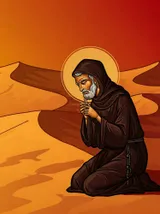What is the History of the Christmas Tree?
Learn about the history of the Christmas tree. Where did the tradition originate, and which saints were involved?
Quiz
1. Please read the question carefully. 2. Think of an answer. 3. Click to check the answer.
❓ Which saint helped start the Christmas tree tradition?
Saint Boniface
🧐 Why did churches have mystery plays?
To help teach the faith to people who couldn't read.
🙋 Which mystery play is connected with the Christmas tree?
The play about Adam and Eve and the Tree of Knowledge is connected to the Christmas tree.
Full Chapter
The use of the Christmas tree is relatively modern. Its origins are found in the medieval mystery plays that depicted the tree of paradise and the Christmas light or candle that symbolized Christ, the Light of the world. According to custom, the Christmas tree is set up just before Christmas and may remain in place until the Solemnity of Epiphany. The lights of the tree are illuminated after the prayer of blessing.
The Christmas tree has been around for a long time, but we only have records of it as we know it today from recent centuries. The traditions surrounding it come from both Christian and non-Christian customs. Here are some of the most important ones that led to the Christmas tree.
Throughout history, people have used plants and flowers that never lose their leaves, called evergreens, in their homes. They believed that these plants had special powers and could protect them from sickness. Different cultures had their favorite evergreen plants, like ivy, mistletoe, holly, butcher's broom, laurel, pine, or fir. They used them for decoration or medicine.
People who lived in cold regions with long, dark winters used certain evergreen plants to give them hope for the upcoming spring. They built temples for a goddess called Flora who was associated with these plants.
St Boniface, eighth-century Bishop
In Germany, there is a popular tradition about the Christmas tree. It is said that it goes back to the eighth century and has a mix of history and legend. The legend is based on St. Boniface, who was a real person. He was an English Bishop and went to Germany to preach Christianity. He went to Hesse, which is a place in Germany.
Boniface preached the Gospel successfully and went to meet with the Pope in Rome. He came back to Germany for Christmas in 723 and was upset when he found out that the Germans had gone back to their old ways of worshiping pagan gods. They were planning to sacrifice a young man under Odin's oak tree to celebrate the winter solstice. Bishop Boniface was very angry, and he took an axe and cut down the oak tree.
The story goes that when Boniface was about to cut down the tree, a sudden gust of wind brought it down. They believed it was a sign from God and asked Bishop Boniface how they should celebrate Christmas. He showed them a small fir tree that had remained standing and asked everyone to take one home, as it was a popular tradition to have an evergreen plant in the house during winter. This event is documented in history and This brave act helped Christianity become the main religion in Germany instead of pagan beliefs.
Medieval religious plays
The Christmas tree that we know today also has its origins in mystery and miracle plays. These plays were performed during the Middle Ages to teach religion because many people couldn't read. Preaching was important to keep the faith alive and to spread the word of the Sacred Scriptures. One of the plays featured the Tree of Good and Evil in the earthly Paradise, which provides an important clue to the history of the Christmas tree.
People used to act out stories from the Bible and Gospel for those who were less educated. This helped them understand the stories better. They did this for special occasions, like celebrating a certain saint or event. These plays became popular all over Europe. One famous play was performed during Christmas time on December 25th.
During Christmas Eve, which is on December 24th, they would act out the story of Adam and Eve in a play. The story is about a tree in a paradise on earth and how Eve picked an apple and Adam ate it. The devil, who was disguised as a serpent, was also in the story. This play was very popular and was a symbol of the original sin, which was later forgiven by Jesus when he was born on December 25th.
The play needed a tree that looked like an apple tree, but since it was winter, they used a fir tree instead. They put some apples on its branches, and also some special biscuits that symbolize the presence of Jesus. They added sweets and gifts for the children too. Even though most people don't have these religious plays anymore, many people still think of the Tree of Paradise as a Christmas symbol.
And that is how we got to the Christmas trees of today! First, in cold climates, many people use evergreen plants to be hopeful in the winter. They also worshipped plants as Gods. When Christianity came to these areas, people stopped worshipping plants and began worshipping the One true God of Christianity. But they still liked the tradition of keeping evergreens in the winter. So the tradition stuck. Later, people began having plays to spread their faith, and an evergreen tree was used to represent the tree of Good and Evil from the Garden of Eden. This tree would be decorated and placed in an important place during the play. These traditions came down to us. Now, many people get a Christmas tree, put it in their house, and decorate it. But not everyone knows why. Now you know!
This has been sdcason courses. Thanks for learning with us and until next time, may God bless you forever and ever.
source: EWTN
Christmas Tree Blessing
In the home the Christmas tree may be blessed by a parent or another family member, in connection with the evening meal on the Vigil of Christmas or at another suitable time on Christmas Day.
When all have gathered, a suitable song may be sung.
The leader makes the sign of the cross, and all reply “Amen.”
The leader may greet those present in the following words:
Let us glorify Christ our light, who brings salvation and peace into our midst, now and forever.
R/. Amen.
In the following or similar words, the leader prepares those present for the blessing:
My brothers and sisters, amidst signs and wonders Christ Jesus was born in Bethlehem of Judea: his birth brings joy to our hearts and enlightenment to our minds. With this tree, decorated and adorned, may we welcome Christ among us; may its lights guide us to the perfect light.
One of those present or the leader reads a text of sacred Scripture, for example, Titus 3:4 (lines 4-7) or Ezekiel 17:22 (lines 22-24; I will plant a tender shoot on the mountain heights of Israel.)
Reader: The Word of the Lord.
R/. Thanks be to God.
The intercessions are then said. The leader says:
Let us ask God to send his blessing upon us and upon this
sign of our faith in the Lord.
R/. Lord, give light to our hearts.
That this tree of lights may remind us of the tree of glory on
which Christ accomplished our salvation, let us pray to the
Lord. R/.
That the joy of Christmas may always be in our homes, let
us pray to the Lord. R/.
That the peace of Christ may dwell in our hearts and in the
world, let us pray to the Lord. R/.
After the intercessions the leader invites all present to say the
Lord’s Prayer.
The leader says the prayer with hands joined:
Lord our God,
we praise you for the light of creation:
the sun, the moon, and the stars of the night.
We praise you for the light of Israel:
the Law, the prophets, and the wisdom of the Scriptures.
We praise you for Jesus Christ, your Son:
he is Emmanuel, God-with-us, the Prince of Peace,
who fills us with the wonder of your love.
Lord God,
let your blessing come upon us
as we illumine this tree.
May the light and cheer it gives
be a sign of the joy that fills our hearts.
May all who delight in this tree
come to the knowledge and joy of salvation.
We ask this through Christ our Lord.
R/. Amen.
The lights of the tree are then illuminated.
The leader concludes the rite by signing himself or herself with the sign of the cross and saying:
May the God of glory fill our hearts with peace and joy, now
and forever.
R/. Amen.
The blessing concludes with a verse from “O Come, O Come, Emmanuel”:
O come, thou dayspring, come and cheer
our spirits by thine advent here;
disperse the gloomy clouds of night
and death’s dark shadow put to flight.
Rejoice! Rejoice! Emmanuel
shall come to thee, O Israel.
source: https://www.usccb.org/prayers/blessing-christmas-tree




